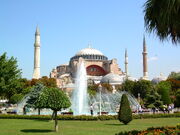GusF (Message Wall | contribs) |
GusF (Message Wall | contribs) |
||
| Line 6: | Line 6: | ||
With that, a mantle of flame bathed the emperor, and he sank into the marble floor before the eyes of the startled priest. Constantinople fell shortly after, and Constantine's body was never found. |
With that, a mantle of flame bathed the emperor, and he sank into the marble floor before the eyes of the startled priest. Constantinople fell shortly after, and Constantine's body was never found. |
||
| − | On June 7, 2003, |
+ | On June 7, 2003, [[Istanbul#Istanbul in "The Emperor's Return"|Istanbul]] was overrun by [[Greece (The Emperor's Return)|Greece]] and the [[Soviet Union#Soviet Union in "The Emperor's Return"|Soviet Union]] during their war with Turkey. Four Greek soldiers entered the Hagia Sophia. Early in the fighting, Turkish snipers had used a minaret had a roost, until a Greek jet destroyed it. |
With the city back in Christian hands, Constantine XI awoke from his slumber shortly after the soldiers entered. Once he announced his intention to assert his rule again, Greek sergeant [[Yannis Pappas]] gunned the emperor down and left his body in the Hagia Sophia. |
With the city back in Christian hands, Constantine XI awoke from his slumber shortly after the soldiers entered. Once he announced his intention to assert his rule again, Greek sergeant [[Yannis Pappas]] gunned the emperor down and left his body in the Hagia Sophia. |
||
Revision as of 20:47, 13 February 2014

Hagia Sophia is a former Eastern Orthodox patriarchal basilica, later a mosque, and now a museum in Istanbul, Turkey. From the date of its dedication in 360 until 1453, it served as the cathedral of Constantinople, except between 1204 and 1261, when it was converted to a Catholic cathedral under the Latin Patriarch of Constantinople of the Western Crusader established Latin Empire. The building was a mosque from 1453 until 1931, when it was secularized. It was opened as a museum in 1935.
Hagia Sophia in "The Emperor's Return"
On May 29, 1453, Emperor Constantine XI Palaiologos entered the Hagia Sophia as the Ottoman Empire overran Constantinople. After informing a priest that he would not flee, Constantine asked for a miracle: to let God see the city in Christian hands again.
With that, a mantle of flame bathed the emperor, and he sank into the marble floor before the eyes of the startled priest. Constantinople fell shortly after, and Constantine's body was never found.
On June 7, 2003, Istanbul was overrun by Greece and the Soviet Union during their war with Turkey. Four Greek soldiers entered the Hagia Sophia. Early in the fighting, Turkish snipers had used a minaret had a roost, until a Greek jet destroyed it.
With the city back in Christian hands, Constantine XI awoke from his slumber shortly after the soldiers entered. Once he announced his intention to assert his rule again, Greek sergeant Yannis Pappas gunned the emperor down and left his body in the Hagia Sophia.
| |||||||||||